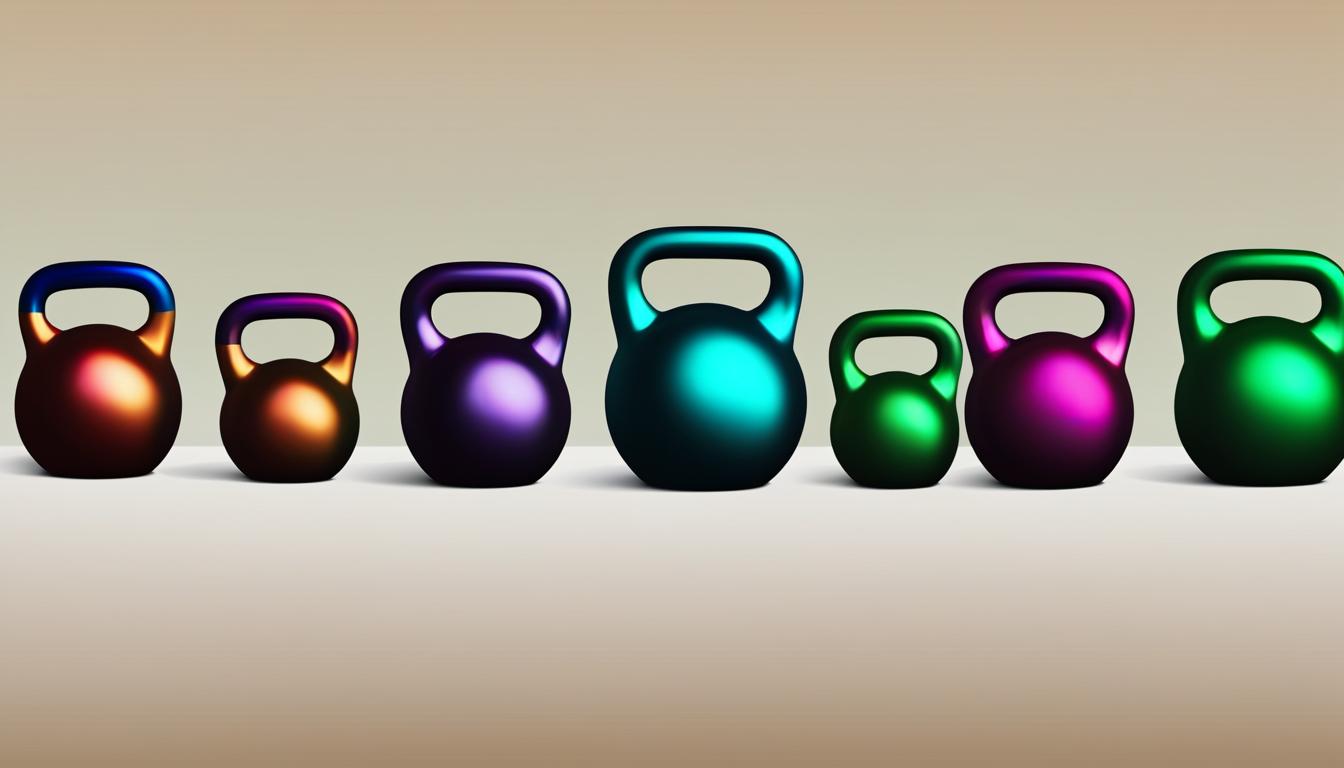Welcome to our comprehensive guide on kettlebell training! Whether you are a beginner looking to kickstart your fitness journey or a seasoned pro seeking to elevate your workouts, this guide has got you covered.
Kettlebell training is a dynamic and effective form of exercise that offers numerous benefits for your overall fitness. From improving strength and endurance to enhancing mobility and stability, incorporating kettlebell exercises into your routine can take your fitness to the next level.
In this guide, we will explore everything you need to know about kettlebell training, including the history of kettlebells, the benefits they provide, how to choose the right kettlebell, and where to start with your training program. Whether you want to sculpt your muscles, boost your cardiovascular fitness, or simply enjoy a challenging workout, kettlebell training has it all.
Key Takeaways:
- Kettlebell training is a versatile and effective form of exercise.
- It offers numerous benefits for strength, endurance, and overall fitness.
- Choosing the right kettlebell and following a structured program is essential.
- Beginners should start with foundational exercises and progress gradually.
- With dedication and consistency, anyone can master kettlebell training and achieve their fitness goals.
A Brief History of Kettlebells

Kettlebells have a fascinating history that stretches back hundreds of years. These unique weights were initially used in various fitness challenges, evolving into a vital tool for training elite soldiers in the Soviet forces. Over time, kettlebells have gained significant popularity in the West, becoming an integral part of many fitness routines today.
Benefits of Kettlebell Training
Kettlebell training offers a wide range of benefits that can help you achieve your fitness goals and improve your overall well-being. By incorporating kettlebell exercises into your training routine, you can experience increased demands on your stabilisation muscles, improved lung and heart capacity, and a full-body workout that requires little space.
One of the primary benefits of kettlebell training is its ability to target and strengthen stabilisation muscles. Unlike traditional weightlifting exercises, which often isolate specific muscle groups, kettlebell exercises require constant coordination and stabilisation of multiple muscle groups throughout the body. This increased demand on stabilisation muscles translates to improved overall strength and stability.
Another advantage of kettlebell training is its ability to improve lung and heart capacity. Many kettlebell exercises, such as the kettlebell swing and kettlebell snatch, involve dynamic movements that require a combination of strength and cardiovascular endurance. This combination leads to improved lung function and increased heart capacity, enhancing your overall cardiovascular fitness.
Kettlebell training also provides a full-body workout, targeting multiple muscle groups simultaneously. With a single kettlebell, you can perform a variety of compound exercises that engage your legs, core, back, arms, and shoulders. This not only saves time but also ensures that you are getting a comprehensive workout in a limited space.
Additionally, kettlebell training promotes improved core integration. The nature of kettlebell exercises, with their swinging and rotational movements, requires a strong and stable core for proper execution. Regular kettlebell training can help strengthen your core muscles, improve your posture, and enhance overall core stability.
Another significant benefit of kettlebell training is the increased strength of ligaments and soft tissues. The controlled and dynamic movements involved in kettlebell exercises put stress on the connective tissues, such as tendons and ligaments, leading to increased strength and resilience over time. This can reduce the risk of injuries and improve overall joint stability.
In summary, kettlebell training offers a wide range of benefits that can enhance your fitness journey. By challenging your stabilisation muscles, improving your lung and heart capacity, providing a full-body workout, promoting better core integration, and increasing the strength of ligaments and soft tissues, kettlebell training offers a holistic approach to fitness. Incorporate kettlebell exercises into your routine and experience the transformative power of this versatile training tool.
Selecting the Correct Kettlebell
When it comes to kettlebell training, choosing the right equipment is crucial for a successful and effective workout.

There are different types of kettlebells available, each with its own features and benefits. Two popular options are competition kettlebells and cast iron kettlebells.
Competition Kettlebells
Competition kettlebells are designed with a more square handle, specifically tailored for single-handed exercises. They are often used in kettlebell sport competitions and provide excellent grip and control during intense workouts. These kettlebells come in a standard size and weight, making them ideal for experienced lifters who want to focus on specific movements and exercises.
Cast Iron Kettlebells
Cast iron kettlebells, on the other hand, are a versatile and widely used option. They have a rounded handle that provides a comfortable grip and are available in a variety of weights. Cast iron kettlebells are known for their durability and solid construction, making them suitable for both beginners and advanced lifters. They are ideal for a wide range of exercises and can help you achieve your fitness goals effectively.
When selecting a kettlebell, it’s essential to avoid certain types that may not offer the same benefits or durability. Kettlebells made of vinyl, for example, may not be as sturdy and can wear out quickly over time. It is also recommended to avoid kettlebells with flat plastic or rubber feet, as they can be less stable during exercises. Additionally, kettlebells with sharp corners or edges should be avoided to prevent any potential injuries or discomfort during your workouts.
By choosing the right kettlebell based on your needs and preferences, you can ensure a safe and effective training experience. Whether you opt for competition kettlebells or cast iron kettlebells, selecting the right equipment is a crucial step in achieving your fitness goals.
What Kettlebell Weight to Use
Kettlebells come in various weights, and choosing the right weight for your fitness level is crucial. Proper kettlebell selection ensures an effective workout while minimizing the risk of injury. Here’s a guide to help you determine the ideal starting weight and progress over time.
Recommended Starting Weights
When starting with kettlebell training, it’s essential to begin with an appropriate weight that challenges you without being too overwhelming. For women, a recommended starting weight is an 8kg kettlebell (approximately 18 pounds). Unconditioned men can start with a 12kg kettlebell (approximately 26 pounds), while average-conditioned men can begin with a 16kg kettlebell (approximately 35 pounds).

Weight Progression for Men and Women
As you progress in your training, gradually increasing the weight of your kettlebell is necessary to continue challenging your muscles and promoting growth. For men, the goal weight is typically a 24kg kettlebell (approximately 53 pounds), with options like 20kg (approximately 44 pounds) and 28kg (approximately 62 pounds) to bridge the gap. Women can follow a similar progression, adjusting the weights according to their own strength and abilities.
Remember, these recommended weights are just a starting point. It’s crucial to listen to your body and find the right balance between pushing yourself and avoiding excessive strain. Always prioritize proper form and technique over lifting the heaviest weight possible. Consistency and gradual progression will ultimately lead to better results and minimize the risk of injury.
Where to Start – Level 1 (Stabilisation)
In order to achieve success with kettlebell training, it is essential to start with a strong foundation. This involves focusing on stabilisation exercises that target important muscle groups and improve core strength and stability.
Two key exercises that should be included in your Level 1 training routine are the Turkish Get Up and the Single Leg Deadlift. These exercises are highly effective in activating and strengthening the stabilisation muscles throughout the body.
The Turkish Get Up
The Turkish Get Up is a full-body exercise that targets multiple muscle groups while requiring stability and coordination. It starts by lying on the floor and gradually moving through various positions until you are standing up, all while holding a kettlebell overhead. This exercise challenges your core, shoulders, hips, and legs, promoting strength and stability throughout the body.
The Single Leg Deadlift
The Single Leg Deadlift is another valuable exercise that emphasizes balance and stability. It involves bending forward at the hips while standing on one leg and holding a kettlebell in the opposite hand. This exercise targets the glutes, hamstrings, and core, improving strength, stability, and proprioception.
By incorporating these stabilisation exercises into your training routine, you will lay a solid foundation for more advanced kettlebell exercises. These exercises not only build strength but also enhance overall stability and core integration, setting you up for success on your kettlebell training journey.
Essential Kettlebell Exercises for Beginners
When starting your kettlebell training journey, it’s important to focus on mastering essential exercises that target multiple muscle groups. These exercises will not only build strength but also improve endurance and mobility. Let’s take a look at four fundamental kettlebell exercises that every beginner should include in their workout routine.
Kettlebell Swing
The kettlebell swing is a powerful exercise that targets the posterior chain, including the glutes, hamstrings, and lower back. It also engages the core muscles, providing a full-body workout. Start with a light kettlebell and master the proper form before increasing the weight. Perform the kettlebell swing by hinging at the hips, swinging the kettlebell between your legs, and explosively driving your hips forward to propel the kettlebell to shoulder height.
Goblet Squat
The goblet squat is an excellent exercise for developing lower body strength and stability. Hold the kettlebell by the horns, close to your chest, and assume a squat position. Keep your chest up, lower yourself down, and drive through your heels to return to a standing position. The goblet squat targets the quads, glutes, and core muscles, making it a must-have exercise for beginners.
Kettlebell Row
The kettlebell row is a compound exercise that primarily targets the upper back, shoulders, and arms. It also engages the core for stability. Start by placing one hand and knee on a bench for support, while holding a kettlebell in the opposite hand. Keep your back straight, retract your shoulder blades, and pull the kettlebell towards your chest, squeezing your back muscles. This exercise helps improve posture and upper body strength.
Kettlebell Deadlift
The kettlebell deadlift is a foundational exercise that targets the entire posterior chain, including the glutes, hamstrings, and lower back. It also activates the core for stability. Stand with your feet hip-width apart, holding the kettlebell with both hands between your legs. Hinge at the hips, maintaining a flat back, and lower the kettlebell to the ground. Drive through your heels to lift the kettlebell back up, focusing on using your glutes and hamstrings.
Developing a Beginner’s Kettlebell Training Program
A well-designed training program is essential for beginners looking to build strength and fitness through kettlebell training. By following a progressive program that balances strength and conditioning, individuals can achieve optimal results. Starting with lighter weights and focusing on perfecting form and technique, beginners can gradually increase the intensity and duration of their workouts, allowing their bodies to adapt and progress.
Building strength and fitness requires a progressive approach, allowing the body to adapt and grow stronger over time. Begin with a weight that challenges you but still allows for proper form and execution of each exercise. This will help to prevent injuries and ensure maximum benefits.
A beginner’s kettlebell training program should focus on a variety of exercises that target different muscle groups and movement patterns. This will help improve overall strength, endurance, and mobility. Incorporating exercises such as kettlebell swings, goblet squats, kettlebell rows, and kettlebell deadlifts can provide a full-body workout and lay the foundation for more advanced movements.
As you progress in your training, gradually increase the weight of the kettlebell and adjust the number of repetitions and sets to continue challenging yourself. This progressive approach will help you build strength and improve your overall fitness level.
Balancing Strength and Conditioning
It’s important to strike a balance between strength and conditioning in your kettlebell training program. Strength exercises focus on building muscle and increasing overall strength, while conditioning exercises focus on improving cardiovascular endurance and stamina.
By incorporating both strength and conditioning exercises into your training program, you can achieve a well-rounded fitness experience. This combination not only helps you develop lean muscle mass and improve your physical appearance but also enhances your overall athletic performance.
Remember to listen to your body and give yourself enough rest and recovery time between workouts. This will allow your muscles to repair and grow stronger. It’s also essential to maintain proper nutrition and hydration to support your training and maximize your results.
“A well-designed training program is the key to success for beginners in kettlebell training. By gradually increasing intensity and focusing on form and technique, individuals can build strength, endurance, and overall fitness.”
Conclusion
Kettlebell training is a versatile and effective way to improve your fitness level and achieve your goals. By mastering the kettlebell basics, selecting the right equipment, and following a well-designed training program, you can build a strong foundation for your fitness journey.
The benefits of kettlebell training are numerous. Not only does it provide a full-body workout that engages multiple muscle groups, but it also improves core strength, stability, and cardiovascular health. Whether you’re a beginner or an experienced lifter, kettlebell training can help you build strength, increase endurance, and enhance your overall fitness.
Building a strong foundation is key to mastering kettlebell training. Starting with stabilisation exercises, such as the Turkish Get Up and Single Leg Deadlift, allows you to develop proper form and technique. From there, you can progress to more advanced exercises and increase the intensity and duration of your workouts. Remember, consistency and dedication are essential for achieving your fitness goals.
So, whether you’re looking to lose weight, gain strength, or improve your athletic performance, kettlebell training is a powerful tool that can take your fitness journey to the next level. Invest in yourself, choose the right kettlebell, and embark on a journey of mastering kettlebell training. Your strong foundation awaits!
FAQ
What is kettlebell training?
Kettlebell training is a type of strength and conditioning workout that uses kettlebells, a type of weight with a handle. It involves performing various exercises and movements with the kettlebell to target different muscle groups and improve overall fitness.
What are some benefits of kettlebell training?
Kettlebell training offers numerous benefits, including increased demands on stabilisation muscles, improved lung and heart capacity, a full-body workout requiring little space, improved core integration, and increased ligament and soft tissue strength.
How do I select the right kettlebell for my needs?
When selecting a kettlebell, it is recommended to choose from competition kettlebells with a square handle for single-handed exercises or cast iron kettlebells with a rounded handle. Avoid kettlebells made of vinyl, those with flat plastic or rubber feet, and those with sharp corners or edges.
What kettlebell weight should I start with?
For women, starting with an 8kg kettlebell is recommended, while unconditioned men can start with a 12kg kettlebell. Average-conditioned men can begin with a 16kg kettlebell. The goal weight for men is usually 24kg, with options like 20kg and 28kg to bridge the gap.
What are some essential kettlebell exercises for beginners?
Essential kettlebell exercises for beginners include the kettlebell swing, goblet squat, kettlebell row, and kettlebell deadlift. These exercises target multiple muscle groups and help build strength, endurance, and mobility.
How do I build a beginner’s kettlebell training program?
To build a beginner’s kettlebell training program, start with lighter weights and focus on perfecting form and technique. Gradually increase the intensity and duration of your workouts to improve strength, endurance, and overall fitness. A progressive program that balances strength and conditioning is recommended.
Is kettlebell training suitable for beginners?
Yes, kettlebell training is suitable for beginners. It is important to start with the basics and focus on building a strong foundation before progressing to more advanced exercises. By mastering the essential kettlebell exercises and following a well-designed training program, beginners can safely and effectively incorporate kettlebell training into their fitness routine.


